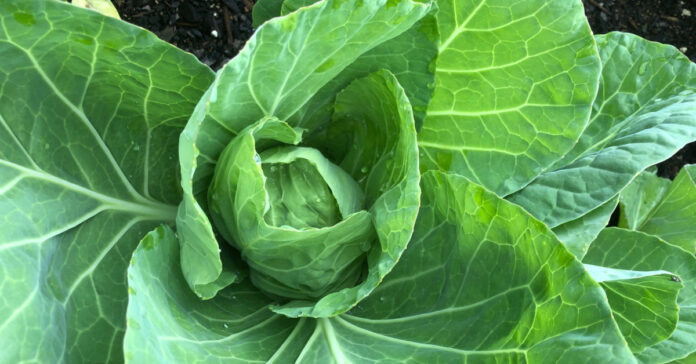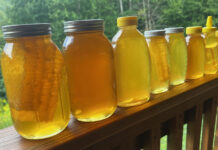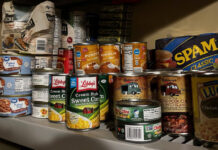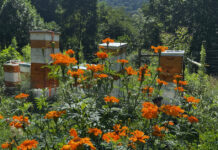I started weed whacking a couple days ago, planning to do the hillside. I got to the end of the driveway and felt the first raindrops. By the time I got back to the garage, it was pouring. We ended up with 1.4 inches of rain that day.
Yesterday started off the same. Cloudy, threatening to rain. I walked the dog in the immediate area in case it started to pour. Sure enough, only a few hundred feet down the hill, I felt incoming raindrops. I hurried back up the hill, but it cleared up before we got there. I kept going past the house, confusing the dog. There was sunshine for three minutes and then it clouded over. Before I finished feeding the chickens, it was raining again. No free range time for them today.
I took advantage of the bad weather to run some errands, including going to our local ACE hardware. Ouch! Inflation is showing its bite. I bought a gallon of paint I needed for the beehives for $37, but I skipped the other item on my shopping list because it was $57.99. I can find the same item online for $39.99. I’m willing to pay a few bucks to support local businesses, but 45 percent more is over my limit.
On top of the higher prices, they are now charging a 3 percent surcharge on all credit card sales. (Another reason to carry cash). When 3 percent means the difference in a company’s survival, that is the sign of tough times and/or a struggling company.
One thing they have going for them is that when you need to make a repair right now, they are the only option within half an hour in any direction. I’ll keep shopping there, but I will use discretion in what I buy.
Normally, I would have gone out for fast food, but I decided to keep saving my dollars. I came home and made an egg sandwich instead. By that time, it was sunny. There was still a bit of wind, but that’s just part of mountain living.
Beehive Report
That afternoon, I decided to inspect the beehives and see how they were doing. The bees continue to fill their supers with honey, but not as quickly as I would like. I’m sure having intermittent days of rain in the middle of the nectar flow didn’t help. I was hoping to harvest spring honey next week, but I think I will have to wait until the end of the month.
Both nucs and both splits are doing well. The nucs are producing honey and the splits are producing bees and will get supers soon. The one weak hive looks about the same as it did last week.
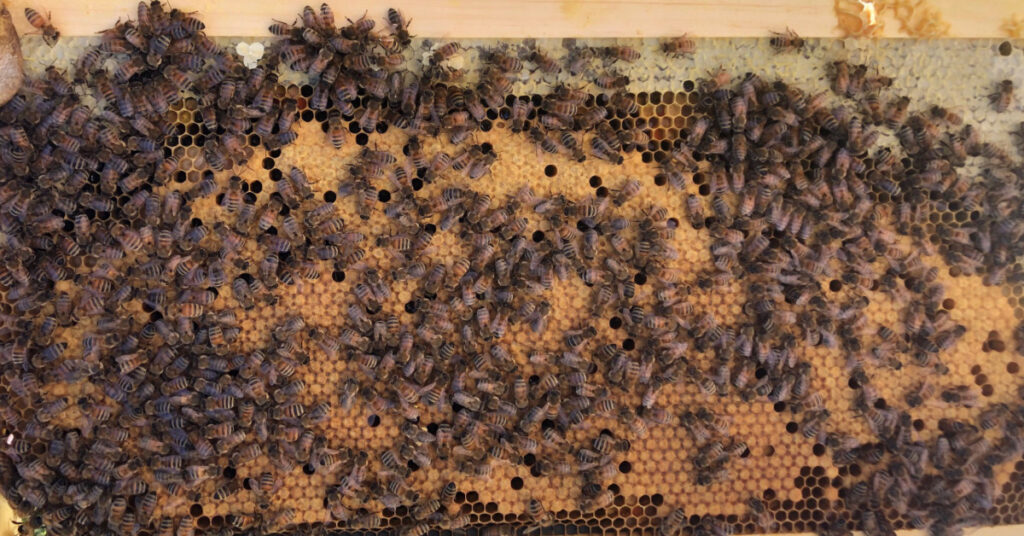
My Mann Lake Experience
Because I have more beehives than I expected, I ran out of equipment. I need more medium supers and more medium frames. Instead of driving to two physical store locations that are 75 and 120 minutes away, I ordered online from Mann Lake Bee Supply because they had free shipping. I ordered five medium supers and 60 plastic medium frames.
Two days later, I get an email stating that the frames are on back order. Disappointing. I call the next day and say, don’t bother shipping me the supers if I can’t get frames. Too late. The supers have shipped. So the nice customer service woman says, “I’m not really supposed to do this, but I’ll ship the frames to you from our California warehouse instead of the Kentucky warehouse.” I’m thinking, why didn’t you do that in the first place? But of course I know the answer, because shipping from California is more expensive.
Two days later, I get an email saying they are out of stock in California, too. WTF! What kind of online company doesn’t have real-time inventory?
So I call again, speak to someone else, and I say, look, just get me some frames. Turns out that they have the frames I wanted in a different color. I tell her I’ll take them. That night, I got an email with the tracking information. Of course, it takes a week to get here from California, but they wasted four or five days because their inventory systems are inaccurate. It was enough to make me wish I’d driven to one of my physical suppliers.
In the meantime, I received the supers, and I have assembled three of them. They are very nice. Higher quality than the ones I buy locally. Looks like I’ll be painting hive equipment again soon.
Garden Update
On May 27, I mentioned how I had planted some old seeds in our garden. Because they were from 2018, I planted twice as many as I needed.
Wouldn’t you know, all the seeds germinated and the young plants are looking good. I am either going to have twice as many cucumbers and summer yellow squash as I want, or I am going to have to pinch some of them off. (I may give one to the neighbor who gave me a tomato plant.)
The cabbage had started forming heads, which is exciting. The potatoes look like they are doing well, but since all the real action is underground, it’s hard to tell. Locals say we’ve been having good potato weather, so I’m crossing my fingers for a robust harvest.
My wife has complained that we grew too much Swiss chard. I explained that when you have a garden, you eat whatever is ripe, even if it means you eat it many days in a row. Then you never have it again unless you freeze or can it. Maybe next year we’ll stagger our plantings so they are not all ripe at once.
Squash for Survival
I grew summer squash and zucchini because they are easy to grow and we will enjoy them, but they are not a priority item for a survival garden. A pound of yellow squash has just under 100 calories in it. Zucchini is about the same. Spaghetti squash isn’t much better. That means a serving gives you less than 30 calories. Butternut squash, a common winter squash, provides only twice as many calories.
Cabbage isn’t much better. Swiss chard and many other leafy vegetables are worse. This is why your survival garden should also include root vegetables and legumes like peas and beans. Beets come in around 200 calories per pound, but potatoes are 347 calories per pound. Green peas, for example, are 367 calories per pound. Green beans are 265 calories per pound. Dried beans are far more, as is dried corn. We would need more space to grow enough peas and beans to provide more than a few meals.
This could be why people add butter to their garden vegetables and eat them as a side dish instead of the main course. Of course, vegetables are also tremendous in soups, stews, casseroles, omelets and other main dishes. Add a few ounces of meat and a cup of rice to your zucchini and summer squash or your greens, and you’ve got 500 calories and a well-rounded meal.
A survival garden is also important because it is a source of fresh food, vitamins and minerals, and will add calories to your plate. Vegetables can also fill you up, giving you and your stomach a full feeling. As food becomes scarcer and more expensive, having a large serving of fried zucchini and yellow squash with an onion or a big serving of cabbage could be very important. But don’t be fooled into thinking you will get all the calories you need from your garden. In most cases, that won’t happen.
Store Grains and Beans
When I look at numbers like these, it just drives home the lesson of why we store rice, beans, wheat, pasta, and canned foods that are calorically dense and provide protein. I’m all in favor of having a large garden and eating out of it as much as you can—now or in a SHTF situation. It’s definitely healthy and helps save money, but it’s going to be difficult to survive on your garden alone unless you have rows and rows of beans and corn that you can harvest, dry, and store.
That’s the beauty of the layered approach to prepping. It gives you have multiple resources, redundancy, and a fall-back plan. For example, garden, but add in some berry bushes, fruit trees, and nut trees to get closer to being self-sufficient. Add in livestock, especially chickens for eggs, pigs for meat, and goats or a cow for dairy and some meat, and surviving on your own food supply gets much easier. Of course, you then have to feed your livestock, which means an even bigger corn field.
Many don’t have the acreage for a cow or goats. That’s OK. Concentrate on what works for your situation, and never limit yourself to depending on only one thing. Whether call it having a plan B, or believing that one is none and two is one, or prepping in layers, it means the same thing: have more than one way to get the job done.

